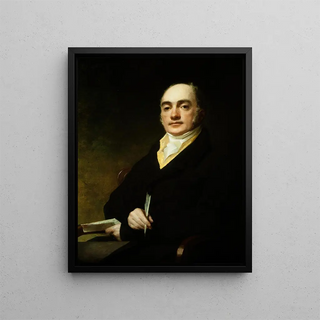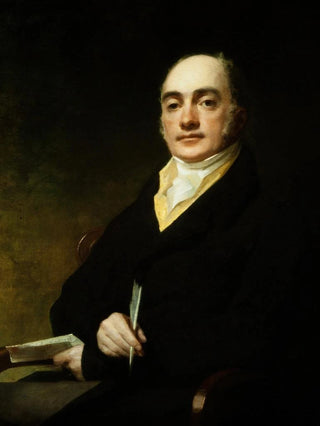Art print | Portrait of John Baillie 1772-1833 - Sir Henry Raeburn


View from behind

Frame (optional)
Portrait of John Baillie 1772-1833 - Sir Henry Raeburn – Captivating Introduction
The "Portrait of John Baillie" by Sir Henry Raeburn, created between 1772 and 1833, is an iconic work that embodies the elegance and finesse of 18th-century Scottish portraiture. This painting, which highlights the personality of an influential businessman of his time, transcends mere representation to become a true window into the human soul. Through John Baillie's penetrating gaze, the viewer is invited to explore the subtleties of psychology and identity. The art print of this work allows for a rediscovery of the evocative power of portraiture and an appreciation of Raeburn's technical mastery.
Style and uniqueness of the work
Raeburn stands out for his innovative approach to portraiture, blending realism and intimacy. In this piece, he manages to capture not only Baillie's physical features but also his very essence. The choice of colors, shadows, and light creates a warm and engaging atmosphere, while the neutral background highlights the character without distraction. Baillie's refined costume, carefully rendered in every detail, reflects his social status while revealing a certain simplicity that makes him approachable. The slightly tilted posture and Baillie's frank gaze suggest an open mind and self-confidence, two essential qualities for a man of his stature. This portrait is thus a celebration of the individual, revealing the complexity of human relationships through the lens of art.
The artist and his influence
Sir Henry Raeburn, a key figure in Scottish art, made his mark on his era with an innovative approach to portraiture. Born in 1756 in Edinburgh, he quickly gained fame thanks to his exceptional talent and his ability to capture the essence of his subjects. Raeburn drew inspiration from old masters while developing a style that was uniquely his own, blending realism and romanticism. His influence extends well beyond his time, inspiring many artists who followed in his footsteps. As a portraitist of Scottish high society, he not only documented an era but

Matte finish

View from behind

Frame (optional)
Portrait of John Baillie 1772-1833 - Sir Henry Raeburn – Captivating Introduction
The "Portrait of John Baillie" by Sir Henry Raeburn, created between 1772 and 1833, is an iconic work that embodies the elegance and finesse of 18th-century Scottish portraiture. This painting, which highlights the personality of an influential businessman of his time, transcends mere representation to become a true window into the human soul. Through John Baillie's penetrating gaze, the viewer is invited to explore the subtleties of psychology and identity. The art print of this work allows for a rediscovery of the evocative power of portraiture and an appreciation of Raeburn's technical mastery.
Style and uniqueness of the work
Raeburn stands out for his innovative approach to portraiture, blending realism and intimacy. In this piece, he manages to capture not only Baillie's physical features but also his very essence. The choice of colors, shadows, and light creates a warm and engaging atmosphere, while the neutral background highlights the character without distraction. Baillie's refined costume, carefully rendered in every detail, reflects his social status while revealing a certain simplicity that makes him approachable. The slightly tilted posture and Baillie's frank gaze suggest an open mind and self-confidence, two essential qualities for a man of his stature. This portrait is thus a celebration of the individual, revealing the complexity of human relationships through the lens of art.
The artist and his influence
Sir Henry Raeburn, a key figure in Scottish art, made his mark on his era with an innovative approach to portraiture. Born in 1756 in Edinburgh, he quickly gained fame thanks to his exceptional talent and his ability to capture the essence of his subjects. Raeburn drew inspiration from old masters while developing a style that was uniquely his own, blending realism and romanticism. His influence extends well beyond his time, inspiring many artists who followed in his footsteps. As a portraitist of Scottish high society, he not only documented an era but






